KEY to SUBFAMILIES
| The Ants of Africa KEY to SUBFAMILIES |
Key to Subfamilies of West Africa and the Congo Basin (developed from Bolton, 1994). Note that the subfamily AENICTOGITONINAE is omitted as it is known only from males.
| 1 |  Body with a single reduced or
isolated segment (the petiole) between alitrunk and gaster; first
gastral segment either entirely confluent with the second or separated
from it only by a narrow girdling constriction, and if the latter then
the first gastral segment is not markedly reduced in size. Body with a single reduced or
isolated segment (the petiole) between alitrunk and gaster; first
gastral segment either entirely confluent with the second or separated
from it only by a narrow girdling constriction, and if the latter then
the first gastral segment is not markedly reduced in size. |
2 |
| -- | 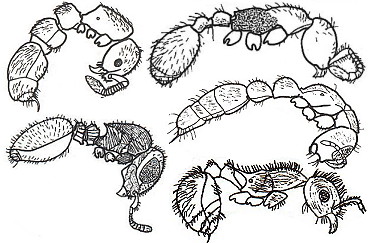 Body with 2 reduced or isolated segments (the petiole and
postpetiole) between alitrunk and gaster; either both segments are much
reduced, or the second is somewhat larger than the first, and if the
latter then the postpetiole is distinctly smaller than the first
gastral segment and separated from it by an extensive, deep girdling
constriction. Body with 2 reduced or isolated segments (the petiole and
postpetiole) between alitrunk and gaster; either both segments are much
reduced, or the second is somewhat larger than the first, and if the
latter then the postpetiole is distinctly smaller than the first
gastral segment and separated from it by an extensive, deep girdling
constriction. |
11 |
| -- | Pedicel with only a single segment distinctly separated from the gaster | -- |
| 2 |  Apex of gaster with a
semicircular to circular acidopore formed from the hypopygium, this
structure often projecting as a nozzle and fringed with setae;
sometimes the acidopore is concealed by a projection of the pygidium,
but if so the antennal insertions are located well behind the posterior
clypeal margin. Sting absent, replaced by an acid-projecting system of
which the acidopore is the orifice. Apex of gaster with a
semicircular to circular acidopore formed from the hypopygium, this
structure often projecting as a nozzle and fringed with setae;
sometimes the acidopore is concealed by a projection of the pygidium,
but if so the antennal insertions are located well behind the posterior
clypeal margin. Sting absent, replaced by an acid-projecting system of
which the acidopore is the orifice. |
FORMICINAE |
| -- | Apex of gaster with hypopygium lacking an acidopore. Sting present or absent; when present it is usually visible but when reduced or vestigial (or present but completely retracted) the hypopygium forms a smooth posterior margin (not modified as above), and the antennal sockets abut the posterior margin of the clypeus. | 3 |
| 3 | Either pygidium or hypopygium armed with peg-like teeth or short spines. If the pygidium is armed it is usually, but not always, transversely flattened to impressed and has either a single pair of short, posterolaterally situated or a marginal row of short spines or peg-like. If the hypopygium is armed then its margin on each side has a row of teeth or spines, generally in the apical half, which project dorsally outside the pygidium. | 4 |
| -- | Pygidium and hypopygium both unarmed. Pygidium transversely convex and rounded, lacking either a posterolateral pair of short spines or a marginal row of short spines or peg-like teeth. Hypopygium with its lateral margins smooth and without spines. | 6 |
| 4 | Gastral spiracles 3-5 (= abdominal spiracles 5-7) exposed, not overlapped nor concealed by the tergites of the preceding segments. Metapleural gland orifice overhung and concealed from above by a cuticular lip or flange, the latter extending obliquely upwards and forwards on the metapleuron as a rim or ridge. Helcium sternite convex and bulging ventrally, visible in profile. | 5 |
| -- | Gastral spiracles 3-5 (= abdominal spiracles 5-7) concealed, overlapped and hidden by the tergites of the preceding segments. Metapleural gland orifice not overhung nor concealed from above by a cuticular lip or flange, and without a rim or ridge extending obliquely upwards and forwards from the gland orifice. Helcium sternite reduced and retracted, not visible in profile. | PONERINAE (part) |
| 5 |  Propodeal spiracle high on side
and situated far forward on the sclerite, the spiracular orifice
subtended by a longitudinal impression. Propodeal lobes absent.
Armament of pygidium consisting solely of a single pair of posteriorly
directed short spines that are situated posterolaterally. Promesonotal
suture always distinct. Propodeal spiracle high on side
and situated far forward on the sclerite, the spiracular orifice
subtended by a longitudinal impression. Propodeal lobes absent.
Armament of pygidium consisting solely of a single pair of posteriorly
directed short spines that are situated posterolaterally. Promesonotal
suture always distinct. |
DORYLINAE |
| -- |  Propodeal spiracle low on side and usually behind the
mid-length of the sclerite, the spiracular orifice not subtended by a
longitudinal impression. Propodeal lobes present. Armament of pygidium
consisting of an apical row or marginal rows of short peg-like teeth or
spines. Promesonotal suture usually completely absent, only extremely
rarely visible. Propodeal spiracle low on side and usually behind the
mid-length of the sclerite, the spiracular orifice not subtended by a
longitudinal impression. Propodeal lobes present. Armament of pygidium
consisting of an apical row or marginal rows of short peg-like teeth or
spines. Promesonotal suture usually completely absent, only extremely
rarely visible. |
CERAPACHYINAE |
| 6 | 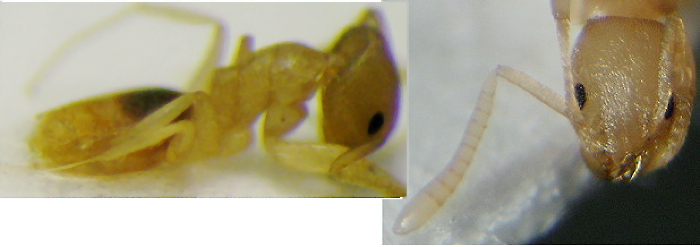 Sting vestigial or absent, in
any case not visible without dissection. Tergite of helcium with an
extensive U- or V-shaped emargination dorsally in its anterior margin
(visible if gaster slightly depressed). Sting vestigial or absent, in
any case not visible without dissection. Tergite of helcium with an
extensive U- or V-shaped emargination dorsally in its anterior margin
(visible if gaster slightly depressed). |
DOLICHODERINAE |
| -- | 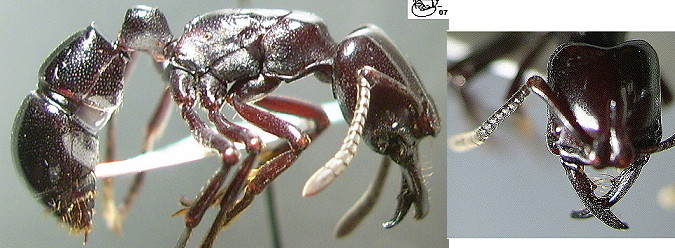 Sting present and functional, often projecting in dead
specimens; in many species the sting shaft is visible through the
cuticle of the gastral apex ventrally even when fully retracted. Sting present and functional, often projecting in dead
specimens; in many species the sting shaft is visible through the
cuticle of the gastral apex ventrally even when fully retracted. |
7 |
| 7 | 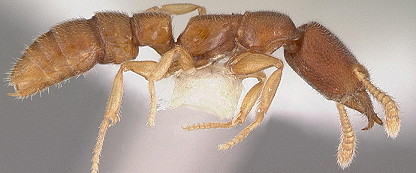 Pedicel of a single segment, with a very broad connection
to the gaster (the helcium) so that the petiole is without a distinct
posterior face. Eyes usually present; clypeus well developed so that
the antennal insertions are some distance behind the anterior margin of
the head. Genae usually not carinate. Frontal carinae usually at least
partially cover the antennal insertions, if not then the dorsum of the
alitrunk is without sutures. Alitrunk dorsally usually with at least
one suture. Pedicel of a single segment, with a very broad connection
to the gaster (the helcium) so that the petiole is without a distinct
posterior face. Eyes usually present; clypeus well developed so that
the antennal insertions are some distance behind the anterior margin of
the head. Genae usually not carinate. Frontal carinae usually at least
partially cover the antennal insertions, if not then the dorsum of the
alitrunk is without sutures. Alitrunk dorsally usually with at least
one suture. |
AMBLYOPONINAE |
| -- | Tergite of helcium entire, its anterior margin dorsally without a U- or V-shaped emargination. | 8 |
| 8 |  Pedicel of a single segment, with a relatively narrow
connection to the gaster (the helcium) so that the petiole has a
distinct posterior face. Eyes usually present but small; clypeus
reduced so that the antennal insertions are close to the anterior
margin of the head. Genae usually not carinate. Frontal carinae reduced
leaving the antennal insertions uncovered. Pygidium never impressed or
armed with spines or denticles. Alitrunk dorsally usually completely
fused. Pedicel of a single segment, with a relatively narrow
connection to the gaster (the helcium) so that the petiole has a
distinct posterior face. Eyes usually present but small; clypeus
reduced so that the antennal insertions are close to the anterior
margin of the head. Genae usually not carinate. Frontal carinae reduced
leaving the antennal insertions uncovered. Pygidium never impressed or
armed with spines or denticles. Alitrunk dorsally usually completely
fused. |
. |
| - | 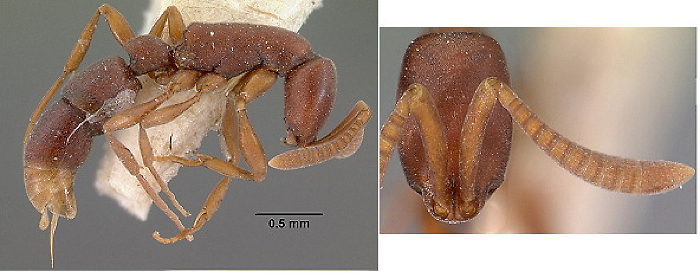 |
PROCERATIINAE |
| -- | Alitrunk with distinct promesontal suture; frontal carinae covering antennal insertions. | 9 |
| 9 | Pretarsal claws with a tooth, or sometimes several teeth, on the inner curvature behind the apical point.. Frontal lobes present and horizontally aligned, partially to completely concealing the antennal sockets. Antennal sockets a notable distance behind the anterior margin of the head, the clypeus well developed in front of them. Spiracles of gastral segments 4 and 5 concealed. Helcium sternite reduced and retracted, not visible in profile. | PONERINAE (part) |
| -- | Pretarsal claws simple, without teeth on the inner curvature behind the apical point Major tibial spur of hind leg broadly and distinctly pectinate, or the metathoracic spiracles not. on the dorsal surface of the alitrunk when viewed from the side (either not visible or on the lateral surface), or both. Palp formula variable, generally not 3,4 but if so then either the petiole lacks a long anterior peduncle or the propodeum lacks spines, or both. | 10 |
| 10 |  Labrum with peg-like teeth.
Propodeal lobes absent. Frontal lobes absent. Eyes absent. Promesonotal
suture present, deeply impressed and flexible. Labrum with peg-like teeth.
Propodeal lobes absent. Frontal lobes absent. Eyes absent. Promesonotal
suture present, deeply impressed and flexible. |
APOMYRMINAE |
| -- | Labrum-without peg-like teeth. Propodeal lobes present. Frontal lobes and eyes usually present, but if either is absent then the promesonotal suture is also absent. | PONERINAE (part) |
| -- | Pedicel of two segments distinctly separated from the gaster | -- |
| 11 |  Pygidium transversely flattened or impressed and armed
laterally, posteriorly, or both, with a row of short spines or peg-like
teeth that usually project vertically. Pygidium transversely flattened or impressed and armed
laterally, posteriorly, or both, with a row of short spines or peg-like
teeth that usually project vertically. |
CERAPACHYINAE (part) |
| -- | Pygidium transversely rounded, may be very small, not armed laterally or posteriorly with a row of short spines or peg-like teeth. | 12 |
| 12 | Frontal lobes either absent or very reduced and vertical; in either case the antennal sockets are completely exposed in full-face view and are not at all concealed or covered by the frontal lobes. | 13 |
| -- | Frontal lobes present, horizontal to somewhat elevated; the antennal sockets are always partially or completely covered by the frontal lobes in full-face view and are never completely exposed. | 16 |
| 13 | Eyes present and conspicuous, with many distinct ommatidia . | 14 |
| -- | Eyes absent or at most represented by a single ommatidium or small, featureless blister. | 15 |
| 14 |  Promesonotal suture present, freely flexible. Hind tibia
with a conspicuous pectinate apical spur. Posterior margin of median
portion of clypeus not projecting back between antennal sockets. Promesonotal suture present, freely flexible. Hind tibia
with a conspicuous pectinate apical spur. Posterior margin of median
portion of clypeus not projecting back between antennal sockets. |
PSEUDOMYRMECINAE (part) |
| -- | Promesonotal suture vestigial (fused and inflexible) to absent. Hind tibia without a pectinate apical spur; spur either simple or (usually) absent. Posterior margin of median portion of clypeus projecting back between antennal sockets. | MYRMICINAE (part) |
| 15 | 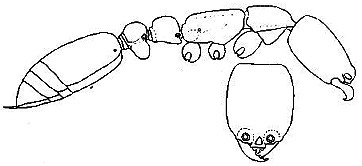 Promesonotal suture present and very conspicuous in dorsal
view; usually deeply impressed and always freely flexible in fresh
specimens. Pygidium large and conspicuous. Spiracles of gastral
segments 3 and 4 concealed by preceding tergites. Sternite of helcium
concealed, not visible in profile. Gaster without deep girdling
constrictions between the segment. Promesonotal suture present and very conspicuous in dorsal
view; usually deeply impressed and always freely flexible in fresh
specimens. Pygidium large and conspicuous. Spiracles of gastral
segments 3 and 4 concealed by preceding tergites. Sternite of helcium
concealed, not visible in profile. Gaster without deep girdling
constrictions between the segment. |
LEPTANILLINAE |
| -- | 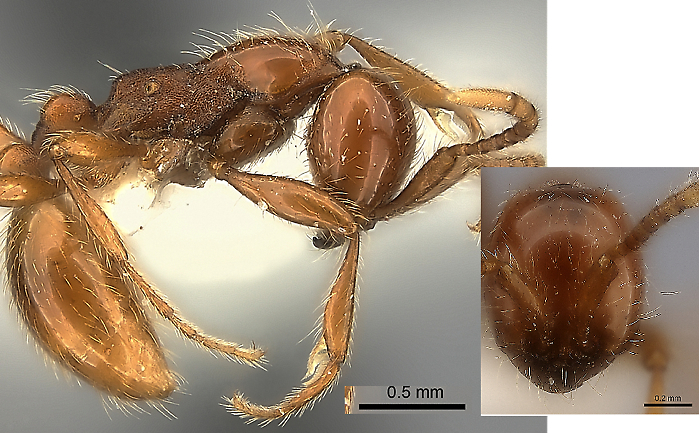 Promesonotal suture vestigial to absent, usually the
latter but very rarely a faint transverse line is visible in dorsal
view; suture never impressed nor flexible Antenna with 8-10 segments.
Spiracle of postpetiole behind midlength of tergite. Gastral spiracles
circular. First- gastral segment with a narrow neck-like constriction
behind the articulation with the postpetiole. Promesonotal suture vestigial to absent, usually the
latter but very rarely a faint transverse line is visible in dorsal
view; suture never impressed nor flexible Antenna with 8-10 segments.
Spiracle of postpetiole behind midlength of tergite. Gastral spiracles
circular. First- gastral segment with a narrow neck-like constriction
behind the articulation with the postpetiole. |
AENICTINAE |
| 16 | 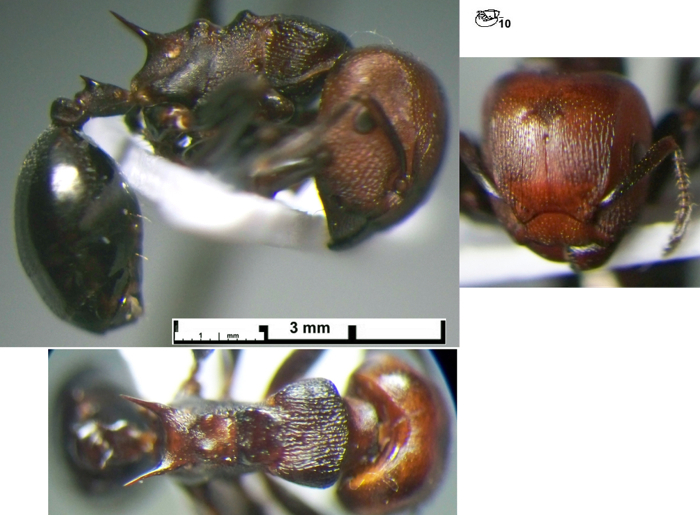 Promesonotal suture usually completely absent; rarely with
a vestigial remnant of the suture in the form of a feeble, transversely
arched impression in dorsal view, but pronotum and mesonotum always
fused and immobile with respect to each other. Promesonotal suture usually completely absent; rarely with
a vestigial remnant of the suture in the form of a feeble, transversely
arched impression in dorsal view, but pronotum and mesonotum always
fused and immobile with respect to each other. |
MYRMICINAE (part) |
| -- | 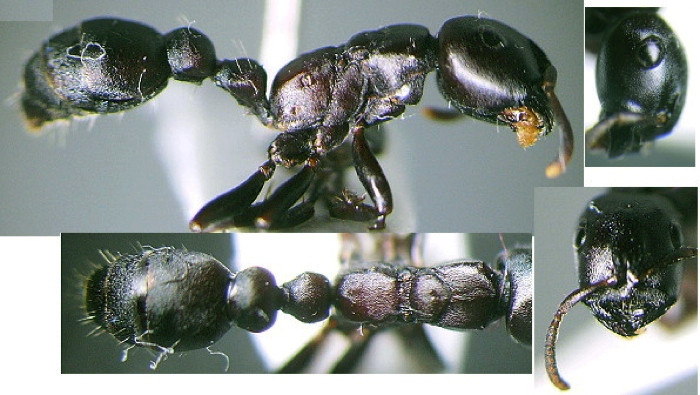 Promesonotal suture present and very conspicuous in dorsal
view, the pronotum and mesonotum not fused, mobile with respect to each
other. Mandibles short, stout, and compact, the apical margin dentate;
mandibles overlapping at full closure but not crossing over, closing
tightly against the clypeus. Stridulitrum present on pretergite of
gastral segment. Promesonotal suture present and very conspicuous in dorsal
view, the pronotum and mesonotum not fused, mobile with respect to each
other. Mandibles short, stout, and compact, the apical margin dentate;
mandibles overlapping at full closure but not crossing over, closing
tightly against the clypeus. Stridulitrum present on pretergite of
gastral segment. |
PSEUDOMYRMECINAE (part) |
|
© 2007, 2013, 2015 - Brian Taylor CBiol FSB FRES 11, Grazingfield, Wilford, Nottingham, NG11 7FN, U.K. |
href="subfamilykey.htm"